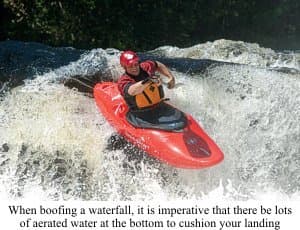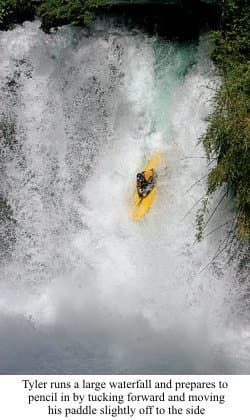Running Waterfalls
Running waterfalls is a unique skill that requires lots of practice and a conservative approach because errors can be very dangerous. Running waterfalls simply isn't for everyone!
If you are interested in running waterfalls I'm going to give you some things to think about. Keep in mind though that every situation is different. Even the same waterfall can offer a totally different situation if water levels change or if the path of the water is altered in any way.
There are two basic approaches to running a waterfall: you can boof, or you can pencil into the water more vertically. As a general rule, the higher the waterfall, the more vertically you'll want to enter the water. Since we recently looked at the boofing technique (which doesn't change when running waterfalls), let's start by looking at when boofing is the right approach to take.
Boofing (landing flat) is the only safe approach to take if the landing zone is shallow, but beware, because boofing can put a lot of strain on your back. In fact there are many cases of paddlers breaking their backs by boofing off waterfalls. It is only reasonable to consider boofing from a relatively low waterfall that has plenty of aerated water at the bottom. Aerated water acts like a cushion for you to land on because there is a high level of air mixed in with the water. Every waterfall will have a different amount of aerated water at the bottom, although there's no accurate way to predict how much there will be. Only scouting can provide that answer.

If boofing isn't the right option for running a waterfall, you'll have to pencil into the landing zone. Before going any further on this topic, it's critical that you understand that pencilling into the water at the base of a waterfall is very risky unless you know exactly how deep the landing zone is. A miscalculation on the depth of the water can be a fatal mistake. So, if there's any doubt as to the water depth the only prudent thing to do is to take the high road and portage the drop.
If you decide to run a waterfall that is too high to boof you need to decide on what type of angle you'd like to pencil into the water. As we mentioned at the beginning of this segment, the higher the drop, the more vertically you'll want to enter the water. The aeration of the landing will also dictate your angle of entry into the water. The more aerated the water is, the less vertical you need to be as the landing will be more cushioned.

Regardless of your chosen angle of entry into the landing zone, you should be sitting upright in your kayak so that you can see your landing as you plunge downward. This upright position also lets you make small adjustments while you're airborne. Believe it or not, the best waterfall runners will even take small strokes in the curtain of the falls on the way down to ensure they hit the water at the correct angle.
A last thing to consider is your body position when you hit the water. If you're pencilling into the landing zone, you'll need to protect yourself by tucking forward, moving your paddle slightly off to the side (away from in front of your face), and turning your head slightly so that the water doesn't hit you full in the face.
As a final note, please remember that these are just some basic guidelines for running waterfalls. Running waterfalls is a risky endeavour and something that you need to work your way up to. One of the great things about whitewater kayaking is that mistakes usually result in a soaking and a damaged ego, but when running waterfalls, mistakes can have much more serious consequences.
This is an excerpt from Ken Whiting's recently revised book, 'The Ultimate Guide to Whitewater Kayaking - 2nd Edition'
Ken is a World Champion Kayaker and the author and producer of an award winning series of instructional kayaking books and videos. He was recognized by "Paddler Magazine" as one of their 'Paddlers of the Century'. For more information, visit www.helipress.com.
Related Articles
How many of you have ever heard that paddle craft (vessels under oars according to the Navigation Rules)…
Even though they are flipping over, missing their gates and failing their maneuvers, they still look…
Driving a car safely involves much more than merely focusing only as far ahead as the taillights of…
The following is a modified excerpt from Ken Whiting's book, 'The Ultimate Guide to Whitewater…



